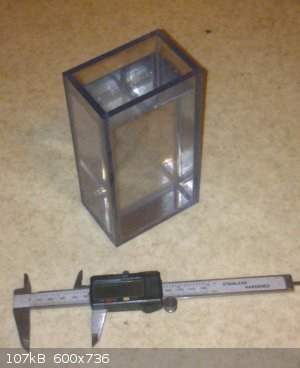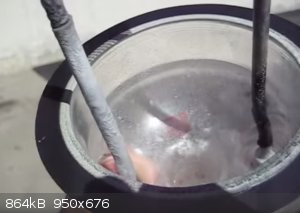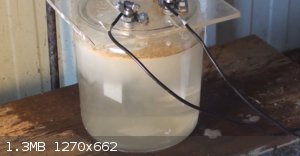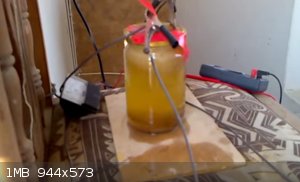| Pages:
1
2
3
4
..
7 |
jock88
National Hazard
   
Posts: 505
Registered: 13-12-2012
Member Is Offline
Mood: No Mood
|
|
It is better to think in terms of 'adding acid' as opposed to 'pH control'.
You simply add acid at a predetermined rate (so many ml per amp per hour) and that's that.
No need for pH probes or monitoring of pH.
|
|
|
Metacelsus
International Hazard
    
Posts: 2531
Registered: 26-12-2012
Location: Boston, MA
Member Is Offline
Mood: Double, double, toil and trouble
|
|
Yes, monitoring of current should be enough.
|
|
|
Fulmen
International Hazard
    
Posts: 1693
Registered: 24-9-2005
Member Is Offline
Mood: Bored
|
|
I've seen that method, but it doesn't really appeal to me. Without any measurements I cannot determine the optimum addition rate properly, and I
really don't like working in the blind like that. Not sure what the consequences are if you add too much acid or how much the pH must be lowered
before there's any real benefit. Getting a reliable dosing system isn't straightforward either, so for now I can't see the benefits outweigh the extra
work&cost. But I will keep it in mind as this project progresses.
So far things seems to run quite well, the erosion of the graphite has dropped to a manageable level and the cell runs like it should. Haven't gotten
any chlorate out yet, but that should be just a matter of time. My planned system is to switch between two charges, this allows me to filter and
freeze out one charge while the other is running. Once I've accumulated enough chlorate too freeze out I should be able to calculate the yield in one
or two day intervals.
Update: We have product! Not much, perhaps an ounce, but it's beautiful.
As for adjusting pH we don't really need an exact value, just something that tells us if it is way off in one direction or the other. Anything that
tells when to add or stop adding acid should provide some control.
[Edited on 2-1-15 by Fulmen]
|
|
|
jock88
National Hazard
   
Posts: 505
Registered: 13-12-2012
Member Is Offline
Mood: No Mood
|
|
Quote: Originally posted by Fulmen  |
Update: We have product! Not much, perhaps an ounce, but it's beautiful.
As for adjusting pH we don't really need an exact value, just something that tells us if it is way off in one direction or the other. Anything that
tells when to add or stop adding acid should provide some control.
[Edited on 2-1-15 by Fulmen] |
Simply adding acid gives you a stable pH once the cell has started up and run for a while (one day).
This has been done time and time again.
Adding acid simply needs a timer attached to a solenoid controlling a valve or a simple dripper (if you have a big cell).
Adding acid a few (at least four IMO) times a day will also
do the job. A second hand medical infusion pump is ideal and can be had for 20 dollars in ebay if you keep an eye out.
Rate of acid needed is approx. 0.146ml 12% HCl per amp per hour.
Read here:
http://oxidizing.typhoonguitars.com/chlorate/reaction.html
CONTROL OF PH IN CHLORATE CELLS
Graphite erosion is not so much of a problem when acid is added (pH 'controlled' if you like). About 20 to 50 grams graphite is eroded per kg Chlorate
produced.
http://oxidizing.typhoonguitars.com/chlorate/reaction.html
pH probes are only needed if you want to experiment and keep on eye on things (nothing wrong with that). If simply making chlorate there is no need
for expensive pH probes. You will need an expensive one, the cheap ones are useless.
long discussion on K chlorate here
http://www.amateurpyro.com/forums/topic/1629-making-potassiu...
[Edited on 2-1-2015 by jock88]
|
|
|
Fulmen
International Hazard
    
Posts: 1693
Registered: 24-9-2005
Member Is Offline
Mood: Bored
|
|
YOU'RE NOT HELPING! I'm trying to keep this project simple, with all your help it's going to grow completely out of control 
But you're right, it shouldn't be as hard as I initially assumed. Since chlorine losses increase as the pH goes down the process is going to be fairly
self regulating. Any reduction in pH should be beneficial, so this might be worth it after all. Thanks for the help.
|
|
|
Fulmen
International Hazard
    
Posts: 1693
Registered: 24-9-2005
Member Is Offline
Mood: Bored
|
|
Now you've done it! I've already started designing a new cell, I'm thinking 6mm clear SAN plastic (glues easily and allows me to see what happens),
appr 700ml volume sized for a 3x6" MMO-anode. I also need to build a peristaltic pump for dosing small volumes. The pump body shouldn't be too hard to
build, as for the driver I'm considering either a monostable vibrator and a self-parking design (think windshield wipers) or a stepper driven unit.
I'm leaning towards the stepper as both the motors and drivers are cheap and versatile...
|
|
|
hyfalcon
International Hazard
    
Posts: 1003
Registered: 29-3-2012
Member Is Offline
Mood: No Mood
|
|
You're going to have severe heating problems if you drive a 3x6 at it's maximum current density. You need at least a 4000ml vessel for that size
anode.
|
|
|
Fulmen
International Hazard
    
Posts: 1693
Registered: 24-9-2005
Member Is Offline
Mood: Bored
|
|
Not going to go anywhere near the limits, as of now I only have a 4A PSU and I'm thinking 8-12A max with suitable cooling. The basic idea is to use a
temp-controlled pump to circulate the liquid through a cooling tank to precipitate the product.
One thing I'm having trouble finding is discussions regarding convection in the cell. With proper pH regulation time is needed to increase yield, in
theory convection could provide some additional reaction time before any chlorine escapes the cell. Has anyone tried this?
|
|
|
hyfalcon
International Hazard
    
Posts: 1003
Registered: 29-3-2012
Member Is Offline
Mood: No Mood
|
|
I've had temperature stratification before and had to run an air pump to mix the layers of temperature variation.
Of course that was a 5 gallon plastic bucket.
[Edited on 4-1-2015 by hyfalcon]
|
|
|
jpsmith123
National Hazard
   
Posts: 764
Registered: 24-6-2005
Member Is Offline
Mood: No Mood
|
|
If you get a MMO anode and you want to try an experiment, here's something that I don't think has been tried yet:
Paint the MMO with a bismuth nitrate & alcohol solution and then heat treat it to decompose the nitrate to oxide. Maybe some of it will form a
pyrochlore with the RuO2 in the MMO coating, and if so you may then have a perchlorate-capable anode. (Right now there are a few sellers on ebay
selling Bismuth Nitrate).
Edit: I'm not sure if bismuth nitrate is soluble in alcohol, but apparently it's soluble in acetone and also glycerin.
Quote: Originally posted by Fulmen  | | Now you've done it! I've already started designing a new cell, I'm thinking 6mm clear SAN plastic (glues easily and allows me to see what happens),
appr 700ml volume sized for a 3x6" MMO-anode. I also need to build a peristaltic pump for dosing small volumes. The pump body shouldn't be too hard to
build, as for the driver I'm considering either a monostable vibrator and a self-parking design (think windshield wipers) or a stepper driven unit.
I'm leaning towards the stepper as both the motors and drivers are cheap and versatile... |
[Edited on 4-1-2015 by jpsmith123]
|
|
|
Fulmen
International Hazard
    
Posts: 1693
Registered: 24-9-2005
Member Is Offline
Mood: Bored
|
|
Nah, not going that route anywhere soon. Electrochemistry isn't my strongest subject, and I try not to indulge in experiments when I'm not competent
to work out the theory. It usually ends up as a waste of time without providing any real new insight. Just building a proper cell with all the bells
and whistles should keep me busy for a long while. Once I'm ready to make perc I'm going to buy a Pt-plated anode, if I ever wear that one out we'll
see about such experiments.
|
|
|
hissingnoise
International Hazard
    
Posts: 3940
Registered: 26-12-2002
Member Is Offline
Mood: Pulverulescent!
|
|
This might be of some interest . . .
|
|
|
markx
National Hazard
   
Posts: 645
Registered: 7-8-2003
Location: Northern kingdom
Member Is Offline
Mood: Very Jolly
|
|
Quote: Originally posted by Fulmen  | | I also need to build a peristaltic pump for dosing small volumes. The pump body shouldn't be too hard to build, as for the driver I'm considering
either a monostable vibrator and a self-parking design (think windshield wipers) or a stepper driven unit. I'm leaning towards the stepper as both the
motors and drivers are cheap and versatile... |
There is really no need to build a dosing pump from scratch:
http://www.ebay.com/sch/i.html?_from=R40&_sacat=0&_n...
http://www.ebay.com/sch/i.html?_odkw=6v+Multifunction+Self-l...
http://www.ebay.com/sch/i.html?_from=R40%7CR40%7CR40%7CR40&a...
Just order one and couple it with a PWM and a timer unit....tunable volumes and preprogrammed timing for the pH control . It probably can't be done
any easier.
http://www.sciencemadness.org/talk/viewthread.php?tid=26826&...
Exact science is a figment of imagination.......
|
|
|
Fulmen
International Hazard
    
Posts: 1693
Registered: 24-9-2005
Member Is Offline
Mood: Bored
|
|
I saw those, but they seemed flimsy. Besides, I have too much in order as it is and all the tools and materials to build one from scratch. I've
started a thread about it here:
http://www.sciencemadness.org/talk/viewthread.php?tid=59870
|
|
|
markx
National Hazard
   
Posts: 645
Registered: 7-8-2003
Location: Northern kingdom
Member Is Offline
Mood: Very Jolly
|
|
Yes, of course you can build a much sturdier pump if you have all the materials and tools at hand. My suggestions were based on the assumption that
building the pump might be a limiting factor to the progress of the main goal of this experiment...the creation of an effective pH controlled cell.
Exact science is a figment of imagination.......
|
|
|
Fulmen
International Hazard
    
Posts: 1693
Registered: 24-9-2005
Member Is Offline
Mood: Bored
|
|
Ah, but you're missing the main goal. To build stuff and have fun 
|
|
|
markx
National Hazard
   
Posts: 645
Registered: 7-8-2003
Location: Northern kingdom
Member Is Offline
Mood: Very Jolly
|
|
Nah....that is pretty much my moto too, but lately I've begun to make some compromises and no longer build ALL of the stuff. The fun has not been
compromised by that so far 
Exact science is a figment of imagination.......
|
|
|
Fulmen
International Hazard
    
Posts: 1693
Registered: 24-9-2005
Member Is Offline
Mood: Bored
|
|
I don't disagree, but right now money is pretty tight. besides, these pumps has a rather high delivery rate which I don't want. Using a stepper solves
that, but that means modifications that might not be so easy with a commercial unit.
|
|
|
Fulmen
International Hazard
    
Posts: 1693
Registered: 24-9-2005
Member Is Offline
Mood: Bored
|
|
Question: What is it that kills pH-probes? If it's the hypochlorite I guess it could be boiled off without affecting pH too much, adjusting the acid
addition by measuring pH would be much simpler than having to measure cell efficiency. But I'm not killing my probe on this, so I'd like to know for
sure if it can be done.
|
|
|
hyfalcon
International Hazard
    
Posts: 1003
Registered: 29-3-2012
Member Is Offline
Mood: No Mood
|
|
I use an IV drip bag with dilute HCl in it. Works for me. Just adjust you concentration of acid to control the pH at whatever level you choose.
Get creative when you get the numbers ironed out and use it to dissolve your extra NaCl in it also. Kill two birds with one stone so to speak.
[Edited on 8-1-2015 by hyfalcon]
|
|
|
Fulmen
International Hazard
    
Posts: 1693
Registered: 24-9-2005
Member Is Offline
Mood: Bored
|
|
Leak testing:

Turned out pretty nice. Still need a lid, but that will probably have to wait to next week.
|
|
|
ecos
Hazard to Others
  
Posts: 464
Registered: 6-3-2014
Member Is Offline
Mood: Learning !
|
|
Hi All,
I just want to share this large cell for chlorate synthesis : http://youtu.be/PwewwZ9-2ok
the graphite rod was corroded ! : http://youtu.be/DH9yICU9p0Q

[Edited on 19-1-2015 by ecos]
[Edited on 19-1-2015 by ecos]
|
|
|
ecos
Hazard to Others
  
Posts: 464
Registered: 6-3-2014
Member Is Offline
Mood: Learning !
|
|
Chlorate/Perchlorate cells
Hi All,
I noticed in some videos on youtube that the electrolysis cell turns yellow as attached pictures.
is this due to the corrosion of anodes?
  
|
|
|
greenlight
National Hazard
   
Posts: 705
Registered: 3-11-2014
Member Is Offline
Mood: Energetic
|
|
I think the yellow colour is quite normal for the cell solution, it could be the chlorine content or maybe electrode corrosion but I am unsure.
I have run a chlorate cell a few times now and have noticed a slight yellow colour to the cell solution which goes away when the cell is cooled down.
In the process of setting up a perchlorate cell now and have everything except the electrodes as the Platinum ones are very expensive.
Has anyone had an success making sodium perchlorate with the cheaper Platinum coated Titanium electrodes as the anode?
Can you get at least one or two batches out of them before they corrode the whole Pt layer off?
The only use for an atomic bomb is to keep somebody else from using one.
George Wald
|
|
|
hyfalcon
International Hazard
    
Posts: 1003
Registered: 29-3-2012
Member Is Offline
Mood: No Mood
|
|
As long as you start with pure chlorate and don't go above 5-6V DC, you can get several runs out of them. Let the chlorate levels get low or
overdirve the voltage and it will peal the platinum right off the titanium.
|
|
|
| Pages:
1
2
3
4
..
7 |